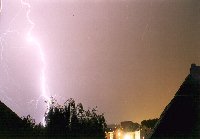In our regions, thunderstorms mainly form in summer. The strong radiation from the sun evaporates a lot of water and heats the air. If then a cold front approaches, the cold air pushes below the warm air, so that the humid and warm air is forced upward. Caused by this process, the vapour condenses, forming cumulus clouds which finally can grow until they become a cumulonimbus. In a cumulonimbus cloud there are heavy upcurrents which hinder the smaller raindrops from falling down from the cloud.
Raindrops and small grains of ice are blown upward again and again. In the upper part of the cloud they freeze and a new layer of ice accumulates. This process is repeated again and again until the grains become so heavy that they cannot be held by the upcurrent any longer. Then very thick raindrops, sleet or even hail falls down from that cumulonimbus cloud. Caused by the anabatic wind inside the cloud and the unequal repartition of ice and water spaces of different electric charges are formed. The upper part of the cumulonimbus normally gets a positive charge, while the lower part has a negative charge. When the voltage between the different charges becomes very high, a lightning forms. There can be a compensation of voltage inside the cloud or between the ground and the lower part of the cloud. In rare cases there can also form a positively charged lightning between the upper part of the cumulonimbus and the ground. To generate a lightning between the cloud and the ground a voltage of more than 100 million volts is necessary.

Around the lightning channel the air gets heated abruptly up to about 40.000 C. This causes a very rapid expansion of the air which causes the thunder. As the speed of sound, contrary to that of light, is only at 330 metres a second, you can calculate the distance from the lightning by the time between lightning and thunder. (3 seconds are equal to about 1 km, 5 seconds to a mile)

A cumulonimbus cloud of an approaching cold front.
In these clouds thunderstorms form.
Photograph made by Mark Vornhusen in spring 1998 through a 25-mm-lens.
© AKM e.V.

